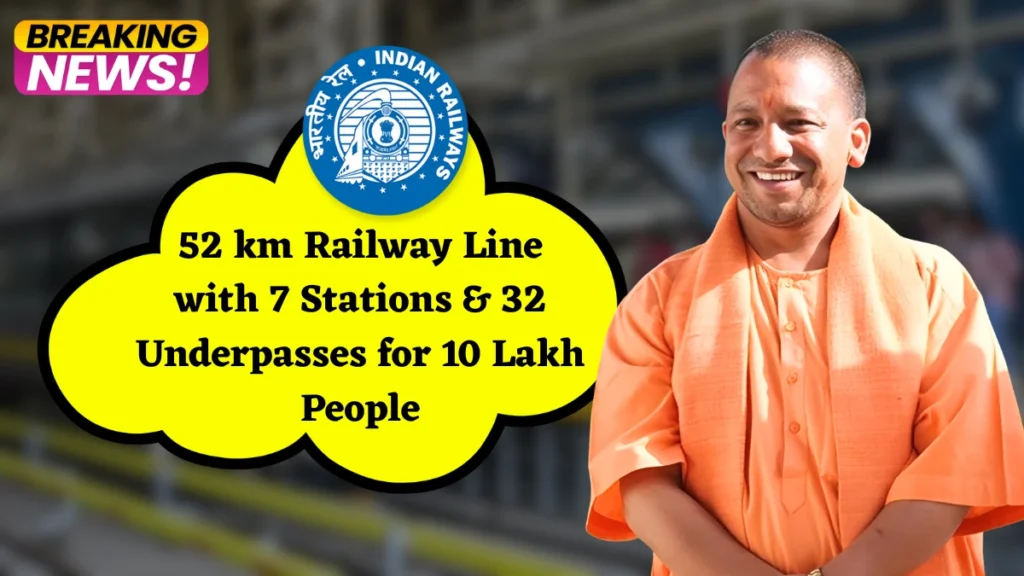Uttar Pradesh, one of India’s most populous and rapidly developing states, is set to witness a significant leap in its transportation infrastructure. The introduction of a new 52-kilometer railway line is poised to transform the way people travel, boosting connectivity for nearly 10 lakh residents across the region. This ambitious project will not only facilitate smoother travel but also promote economic growth and social development in the connected areas.
The new railway line, designed with modern facilities, will include seven stations strategically positioned to maximize accessibility. This enhancement in rail infrastructure is expected to create multiple opportunities for commuters, businesses, and local communities.

Transforming Daily Commutes for Millions
The railway line will serve approximately 10 lakh people, connecting various towns and villages that previously struggled with limited transportation options. For daily commuters, this railway will drastically reduce travel times and provide a more comfortable, reliable alternative to road transport. The availability of seven stations along the route ensures that people from different localities will benefit equally.
This connectivity is particularly vital for those who rely on public transportation to reach their workplaces, schools, and markets. With a direct and efficient rail link, people will have improved access to employment opportunities and essential services, fostering greater economic inclusion and social mobility.
Strategic Placement of Stations
The seven stations along this railway line are carefully planned to cover important population centers and emerging urban hubs. Each station acts as a focal point, not only for passenger boarding and alighting but also as a catalyst for local development.
As a result, these stations are expected to encourage the growth of small businesses, such as retail shops, eateries, and transport services. Over time, this will stimulate local economies and generate new employment opportunities for residents. The railway stations will also become community spaces where people can connect and engage in cultural and social activities.
Safety and Accessibility with 32 Underpasses
One of the standout features of this project is the construction of 32 underpasses along the railway route. These underpasses are designed to enhance safety for both pedestrians and vehicles by eliminating dangerous level crossings. They allow uninterrupted flow of traffic, reducing the chances of accidents and improving overall transportation efficiency.
Moreover, the underpasses will ease the movement of agricultural machinery and emergency vehicles, which is critical in rural areas where roads are often narrow and congested. This aspect of the railway project reflects a deep understanding of the region’s needs, ensuring that infrastructure development benefits every sector of society.
Economic Impact Beyond Transportation
Beyond improving daily travel, the new railway line holds the promise of significant economic benefits for the region. Enhanced connectivity often leads to increased trade and investment, as goods and services can move more freely and quickly.
Local farmers and producers will find it easier to transport their products to larger markets, reducing costs and expanding their customer base. Small and medium enterprises will also gain from the improved supply chains and greater access to raw materials and customers.
Additionally, the railway will likely attract new businesses and industries seeking to capitalize on the improved transportation network. This can lead to job creation and a more diversified local economy, reducing dependence on agriculture alone.
Environmental and Social Benefits
Rail transport is widely recognized as an environmentally friendly alternative to road transport. The introduction of this new railway line will help reduce the carbon footprint of daily commutes and freight movement by shifting a significant number of travelers and goods from road to rail.
This shift is expected to decrease air pollution and traffic congestion on highways, improving the quality of life for residents in the connected regions. Socially, better rail connectivity fosters greater integration between urban and rural areas, facilitating cultural exchange and mutual understanding.
The railway will also promote inclusivity by providing affordable transportation options for people from different economic backgrounds, including women, students, and senior citizens.
Challenges and Future Prospects
While the new railway line brings many opportunities, it also poses challenges that need careful management. Construction and maintenance require ongoing investment, and there must be a focus on ensuring that operations remain efficient and safe.
Community engagement will be crucial to address concerns such as land acquisition and environmental impact. Authorities must work closely with local populations to ensure that the project respects their rights and benefits everyone equitably.
Looking ahead, this railway line can serve as a model for future infrastructure projects in Uttar Pradesh and beyond. Continued expansion of the rail network, integration with other transport modes, and adoption of smart technologies can further enhance the region’s connectivity and development.
Conclusion: A Pathway to Progress
The 52-kilometer railway line in Uttar Pradesh is more than just a transportation project; it represents a pathway to progress for nearly one million people. By connecting communities, enabling safer travel, and stimulating economic growth, this railway line is set to improve the quality of life for countless individuals.
As this project moves forward, it embodies the potential of modern infrastructure to transform societies and build a brighter future. The journey of these 52 kilometers will surely carry the hopes and aspirations of many, driving Uttar Pradesh closer to its vision of inclusive and sustainable development.
Disclaimer: The information provided in this blog is based on current plans and publicly available data. Project details may evolve over time due to government decisions or unforeseen circumstances. Readers are encouraged to verify facts from official sources before making any travel or investment decisions related to the railway line.